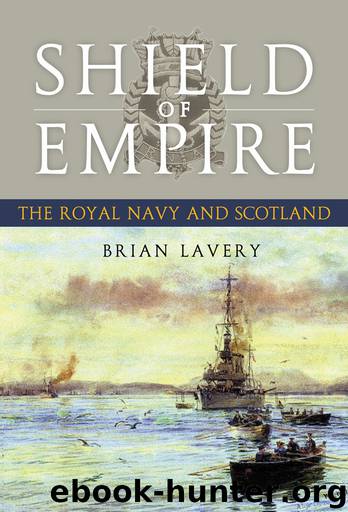Shield of Empire by Brian Lavery

Author:Brian Lavery [Lavery, Brian]
Language: eng
Format: epub
ISBN: 9780857905420
Publisher: Birlinn
British Minefields
The Royal Navy had taken comparatively little interest in mines before the war, except for purely defensive purposes in certain harbours. It had only 4,000 in stock, all of one type which was to prove defective in service. Nevertheless a controlled field of eighteen mines, which could be made live by an operator on shore, was laid across the relatively narrow entrance to the Tay at Broughty Ferry. It was done in too much of a hurry and they had to be raised in March 1915, and twenty-four larger mines were laid in their place, in five lines.30 The minelaying policy had now been extended and orders were placed for new and much larger mines. Much of the work on the east coast was ‘independent’ minefields, intended initially to forestall the activities of German minelaying submarines.31 Later on, they were intended against all kinds of U-boat activity.
The first such field in Scottish waters was off Tod Head, one of several headlands where U-boats were known to linger in search of prey. The mines were laid in June 1915 at a depth of 48 ft to prevent interference with surface shipping, and they were 150 ft apart. Two months later a deep minefield was laid off the Firth of Forth and in October fields were laid near South Carr off Fife Ness and in St Andrews Bay to the north. Plans for further fields off Fife Ness and the Isle of May were vetoed by Admiral Jellicoe, who feared they might interfere with the movements of his ships in the Forth.32 But after the Moewe’s expedition to the Moray Firth, Jellicoe had three deep minefields laid in 1916, at great trouble, in Lybster Bay, Tarbet Ness and Stotfield Head off Lossiemouth. A field was laid across three-quarters of the North Channel between Scotland and Ireland in May 1918, using American cruisers and Clyde puffers based at Lamlash on Arran.33 However, the long minefield off the east coast of England, the East Coast Barrage, intended to keep U-boats away from the coastal convoy routes, did not extend as far as Scottish waters.
Minelayers came from several sources. At the beginning of the war seven old cruisers had been converted, but they were too slow to reach the desired area under cover of darkness, lay the mines and escape without detection. Other minelayers were converted from fast merchant ships, mostly built by Denny of Dumbarton who had specialised in ferries for many years. The most successful were the Princess Irene and Princess Margaret, intended to run from Vancouver to Seattle but taken over when almost complete on the outbreak of war. They were oil-fuelled, which was a great advantage in smoke control, had a speed of 20 to 21 knots and could carry up to 500 mines. The Princess Irene blew up at Sheerness in 1915.
The Biarritz and Paris were smaller ships intended as ferries from Dover to Calais. They too were taken over in Denny’s before completion but were slightly less successful.
Download
This site does not store any files on its server. We only index and link to content provided by other sites. Please contact the content providers to delete copyright contents if any and email us, we'll remove relevant links or contents immediately.
| Automotive | Engineering |
| Transportation |
Whiskies Galore by Ian Buxton(41533)
Introduction to Aircraft Design (Cambridge Aerospace Series) by John P. Fielding(32890)
Small Unmanned Fixed-wing Aircraft Design by Andrew J. Keane Andras Sobester James P. Scanlan & András Sóbester & James P. Scanlan(32574)
Craft Beer for the Homebrewer by Michael Agnew(17935)
Turbulence by E. J. Noyes(7702)
The Complete Stick Figure Physics Tutorials by Allen Sarah(7143)
Kaplan MCAT General Chemistry Review by Kaplan(6597)
The Thirst by Nesbo Jo(6439)
Bad Blood by John Carreyrou(6278)
Modelling of Convective Heat and Mass Transfer in Rotating Flows by Igor V. Shevchuk(6225)
Learning SQL by Alan Beaulieu(6037)
Weapons of Math Destruction by Cathy O'Neil(5832)
Man-made Catastrophes and Risk Information Concealment by Dmitry Chernov & Didier Sornette(5650)
Digital Minimalism by Cal Newport;(5392)
Life 3.0: Being Human in the Age of Artificial Intelligence by Tegmark Max(5189)
iGen by Jean M. Twenge(5163)
Secrets of Antigravity Propulsion: Tesla, UFOs, and Classified Aerospace Technology by Ph.D. Paul A. Laviolette(4994)
Design of Trajectory Optimization Approach for Space Maneuver Vehicle Skip Entry Problems by Runqi Chai & Al Savvaris & Antonios Tsourdos & Senchun Chai(4843)
Electronic Devices & Circuits by Jacob Millman & Christos C. Halkias(4749)
